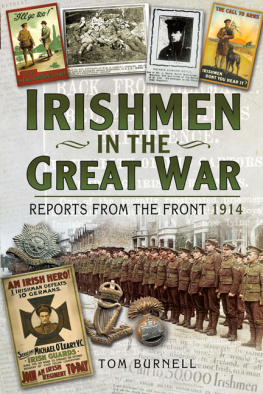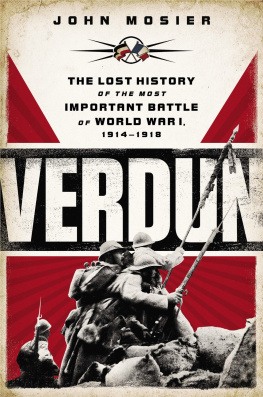MICHELIN'S ILLUSTRATED GUIDES
TO THE BATTLE-FIELDS (1914-1918)
VERDUN
Argonne-Metz
1914-1918
MICHELIN & CieCLERMONT-FERRAND
MICHELIN TYRE Co LtdLONDON
MICHELIN TIRE CoMILLTOWN, N.J., U.S.A.
Diploma by Georges SCOTT, given to Subscribers, by the Committee of the
Memorial Fund of the Mortuary of Douaumont.
MEMORIAL FUND
TO THE
DEFENDERS OF VERDUN
MORTUARY OF DOUAUMONT
(A War Fund authorised by Ministerial decree dated 3/12/19)
On the battlefield of Verdun, millions of men engaged in a battle of giants; 400,000 French soldiers fell there on a front of 20 kilometres.
A fund has been established with the object of erecting a Mortuary in the centre of the battlefield, at a point whence the whole field may be viewed.
The site chosen is situated between the Fort of Douaumont and the Thiaumont redoubt (See of this Guide).
The Patrons are Marshal Foch , M. Raymond Poincar , and His Excellency, the cardinal Dubois .
The executive Committee, under the honorary presidency of Marshal Ptain , is presided over by S. G. Mgr Ginisty , Bishop of Verdun, General Boichut , commanding the 12th Infantry Division, the Commandant of Verdun, General Valantin , formerly commanding the town and forts of Verdun and the Hauts-de-Meuse.
The names of all subscribers will be registered in a golden Book to be kept in the basilica. At the top of the list will be the names of the Founder members who have subscribed 500 francs or more. On the inside walls of the monument will be carved inscriptions which families may wish to place in memory of their dead.
An artistic diploma by Georges Scott is sent to every subscriber of 20 francs, on which there is a reproduction of Marshal Ptain's autograph and an acknowledgement of the subscriber's interest in the memorial (Photo. herewith).
Subscriptions may be sent: to Verdun, to S. G. Mgr Ginisty , Bishop of Verdun, and to Me Schleiter , solicitor; to Paris, to Princess Henri de Polignac , 26, avenue Montaigne.
Advertisement for the Guide Michelin
2 inseparables
The Michelin Road Map
and Guide.
- The Guide, for the town.
- The Map, for the country.
They complete one another, without overlapping.
Use them together.
IN MEMORY
OF THE MICHELIN EMPLOYEES
AND WORKMEN WHO DIED GLORIOUSLY
FOR THEIR COUNTRY
VERDUN
Argonne-Metz
(1914-1918)
Copyright 1919 by Michelin & Cie.
All rights of translation, adaptation or reproduction (in part or whole) reserved in all countries.
View of Verdun from the air.
VERDUN
ORIGIN AND POLITICAL HISTORY
Verdun, one of France's most ancient cities, was first a Gallic, then under the name of Virodunum Castrum, a Roman fortress. In 843 the celebrated treaty which divided the Carolingian Empire and annexed Verdun to the Kingdom of Lorraine was signed there. From 870 to 879 Verdun became part of France, but in 923 it was incorporated in the German Empire. As a county, it was governed under the feudal system by the hereditary counts, the last of whom was Godefroy de Bouillon, and later by the episcopal counts and bishops.
In the 10th century, Bishop Haimont, of Verdun, persuaded the Count of Verdun to transfer his rights to him. The arrangement was confirmed by Emperor Othon III, but the count's heirs disputed the bishops' title to the town. Later, the burgesses revolted against the authority of the bishops, and after a sanguinary struggle succeeded in throwing off their yoke about the middle of the 13th century. After a long occupation by the Germans, Henri II, King of France, retook Verdun in 1552 and granted it privileges which were confirmed by Franois II in 1559. During the Religious Wars, the town was for the Leaguers, and only agreed to receive Henry IV's envoy, after that prince's conversion to the Roman Faith. The burgesses did not take the oath of allegiance to the King of France until 1601.
CHIEF MILITARY EVENTS
Both in respect of its geographical position and history, Verdun is a typical fortified town. From time immemorial it has played an important part in resisting invasion, as witness its fortified camp and citadel. Since 1870 it has been the centre of a stronghold formed by a rough semi-circle of hills and slopes bristling with defensive works and batteries.
Since the year 450, when Attila left it "like a field ravaged by wild beasts", it has been besieged at least ten times.
Charles the Fifth besieged and took it in 1544, but after a seven years occupation it was retaken by Henry II of France in 1552. The Huguenots tried to take it by surprise in 1589, but were unable to overcome the resistance of the citizens.
Siege of 1792.In 1792, the Prussians attacked and bombarded the town, defended by Beaurepaire with only thirty-two guns and forty-four artillerymen. The Council of Defence, urged thereto by the Anti-Republican section of the population, decided to capitulate, in spite of opposition on the part of Beaurepaire, who died soon afterwards at the Town Hall by his own hand, according to some, others holding that he was assassinated. The Prussians occupied the town for six weeks, after the garrison had left. Although it is true that a few women went to the Camp of Bras with an offering of sweetmeats for the King of Prussia, it has not been established that the latter gave a ball at Regret, at which the women of Verdun danced. The victory of Valmy forced the Prussians to leave Verdun. On October 13th, Kellermann took possession of the Citadel, and on the 14th the troops of the Republic entered the town. Several of the visitors to the Camp of Bras expiated their regrettable act on the scaffold.
Siege of 1870.In 1870, Verdun offered a more stubborn resistance. When the Saxon troops, about 10,000 in number, appeared to the east of the town, the garrison of the latter comprised only 1,500 regular troops, including fifty artillerymen, 2,000 untrained men and 1,400 men of the National Sedentary Guard, while its armament consisted of twenty mortars, twenty-one howitzers and ninety-six guns, of which the barrels of only forty-six were rifled. Under the command of General Gurin de Waldersbach, seconded by General Marmier, this small garrison repulsed a violent attack on August 24th, and refused to surrender. After being reinforced by 2,600 men who had escaped from Sedan, several sallies were made. By September 23rd the enemy had completely encircled the town, and were forcing the inhabitants of the surrounding villages to help with the siege-works. On the night of October 19th, thirty sappers, twenty-five artillerymen and 100 foot soldiers surprised the two German batteries on Heyvaux Hill, between Thierville and Regret, on the left bank, and after hand-to-hand fighting, spiked all the guns.
After the fall of Metz, Verdun, besieged by 15,000 men with 140 heavy guns, in addition to field artillery, surrendered on November 8th with the honours of war.
The town had been bombarded three times. On August 24th it received about 2,000 shells; on September 26th the Citadel received 1,000 to 1,200 shells in five hours; on October 13th, 14th and 15th 20,000 to 25,000 shells fell in the town, severely damaging the upper part and the Citadel.
The name of the German Prefect who governed Verdun and the Meuse province was Von Bethmann Hollweg.
September 9th 1914.The Battle of the Marne.
















